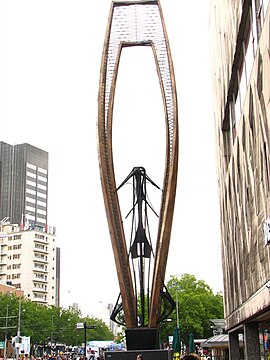 | Draft article not currently submitted for review.
This is a draft Articles for creation (AfC) submission. It is not currently pending review. While there are no deadlines, abandoned drafts may be deleted after six months. To edit the draft click on the "Edit" tab at the top of the window. To be accepted, a draft should:
It is strongly discouraged to write about yourself, your business or employer. If you do so, you must declare it. Where to get help
How to improve a draft
You can also browse Wikipedia:Featured articles and Wikipedia:Good articles to find examples of Wikipedia's best writing on topics similar to your proposed article. Improving your odds of a speedy review To improve your odds of a faster review, tag your draft with relevant WikiProject tags using the button below. This will let reviewers know a new draft has been submitted in their area of interest. For instance, if you wrote about a female astronomer, you would want to add the Biography, Astronomy, and Women scientists tags. Editor resources
Last edited by Dclemens1971 (talk | contribs) 2 months ago. (Update) |
| Untitled (The Stylized Flower) | |
|---|---|
 The Stylized Flower in 2006 | |
| Artist | Naum Gabo |
| Year | 1957 |
| Medium | Iron |
| Dimensions | 2620 cm × 520 cm (1,030 in × 200 in) |
| Designation | Rijksmonument |
| Location | De Bijenkorf, Coolsingel, Rotterdam |
The Stylized Flower is the nickname for an untitled Dutch artwork located at the entrance of De Bijenkorf in Rotterdam, designed by Naum Gabo. It is considered the most important work in his oeuvre.[1] Commonly referred to as "the thing" in casual conversation, the sculpture was installed in May 1957 for the new De Bijenkorf building.
Construction
editThe artwork stands 26.2 meters tall and measures 4.8 meters by 5.2 meters at its widest points. It consists of four main steel ribs and four inner steel ribs, all with a square cross-section, enclosing a smaller "inner image."
The main and inner ribs form four helicoid planes, each bounded by one main and one inner rib. These are connected in the plane with horizontal round bars, and the helicoid plane is further delineated by mesh. The main and inner ribs are twisted along their entire length in alignment with the helicoid plane. At the top and bottom, the ribs are connected by square cross-section bars. The main structure is metallized with aluminum bronze, polished, and clear lacquered.
The "inner image" is constructed from steel box sections, steel plate, and stainless steel springs. The springs are tensioned between the profiles to form surfaces, with those in the center having a strongly curved saddle shape. The "inner image" is flexibly attached to the main structure at the top with spacers. The "inner image" is black except for the springs, which are bare metal.
Restoration
editIn 1960, the artwork caught fire during maintenance work intended to prevent rust, causing significant damage to the facade of De Bijenkorf. It took a year and a half to repair the damage.[citation needed]
After prolonged disputes over who would cover the costs,[2] the sculpture was restored in 2017–2018. The restoration cost around 700,000 Euros and was paid by the owner of the artwork, Bouwfonds.[3]
Trivia
editThe sculpture is privately owned. Until 2007, De Bijenkorf owned the sculpture. Since then, a real estate consortium has been the owner.[citation needed]
References
edit- ^ "Nog heel even en 'De Gestileerde Bloem' valt om", NRC, 26-02-2008. [dead link]
- ^ "Rotterdam betaalt geen cent aan restauratie Het Ding", Rijnmond. Archived on 17 May 2021.
- ^ "Het Ding staat er weer", Rijnmond.
External links
edit51°55′13.02″N 4°28′45.99″E / 51.9202833°N 4.4794417°E